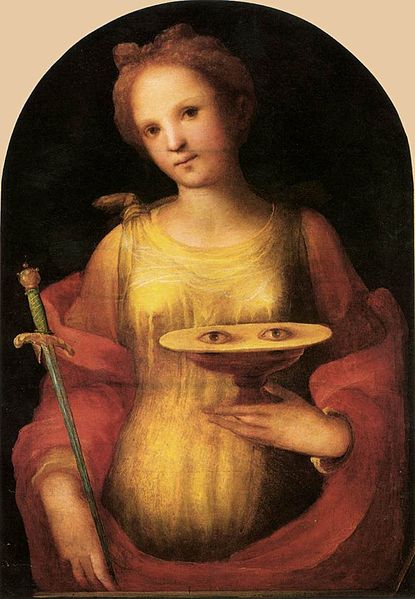settings
Middlemarch vocabulary
21 Christianity and/or Biblical vocabulary words
help & settings
[x]
-
Saint Lucy
-
► definition
Definition:[283 - 304]a young Christian martyr who died during the Diocletianic Persecution. She is venerated as a saint by the Roman Catholic, Anglican, Lutheran, and Orthodox Churches. She is one of eight women who, along with the Blessed Virgin Mary, are commemorated by name in the Canon of the Mass. Her feast day, known as Saint Lucy's Day, is celebrated in the West on 13 December. St. Lucia of Syracuse was honored in the Middle Ages and remained a well-known saint in early modern England.[...]The oldest record of her story comes from the fifth-century Acts. Jacobus de Voragine's Legenda Aurea was the most widely read version of the Lucy legend in the Middle Ages. In medieval accounts, Saint Lucy's eyes are gouged out prior to her execution.[...]The emblem of eyes on a cup or plate apparently reflects popular devotion to her as protector of sight, because of her name, Lucia (from the Latin word "lux" which means "light"). In paintings St. Lucy is frequently shown holding her eyes on a golden plate. Lucy was represented in Gothic art holding a dish with two eyes on it. She also holds the palm branch, symbol of victory over evil.text from Wikipedia, licensed under Creative Commons - Attribution - Sharealike painting: by Domenico di Pace Beccafumi
painting: by Domenico di Pace Beccafumi
► uses
Uses:
[Caravaggio] painted prodigiously and swiftly, large public commissions for churches and smaller works for wealthy patrons who knew his fame and clamored for his works. [...] In Syracuse, for the church of Santa Lucia, The Burial of Saint Lucy.
Jonathan Harr. The Lost Painting, p.224 (2006)
---
for the inspection of macerated muscle or of eyes presented in a dish (like Santa Lucia's), and other incidents of scientific inquiry, are observed to be less incompatible with poetic love than a native dulness or a lively addiction to the lowest prose.George Eliot. Middlemarch

